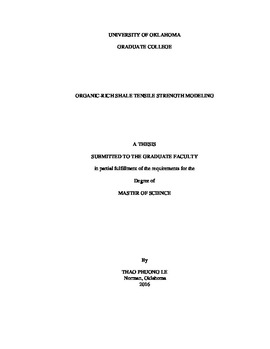| dc.description.abstract | Shale mechanical characterization is an expensive and time intensive lab and field exercise. Experimental observations in lab shale characterization have shown some relation (linear or non-linear) between fracture toughness and tensile strength. Both fracture toughness and tensile strength measurements require a lot of laboratory work, yet porosity and mineralogy estimation can be quickly and easily obtained using conventional logging tools. In this study, attempts were taken to predict fracture toughness and tensile strength as a power function of clay and non-clay phase porosity and correlate this to the shale matrix organic content. The model was then expanded to relate to Mode-I fracture toughness of shale as well. It was also verified by experimental results of the same data set of Woodford shale in this work.
Using the data set of Woodford shale, the correlations between lateral tensile strength, Tp, with non-clay mineral content, clay content, TOC, and porosity were observed. It was suggested that all of these individual components might add up to a single, yet more representative, parameter called clay packing density or alternatively, clay phase porosity. This property describes how tightly the clay particles are packed together in the shale mineral matrix. Combining this knowledge with previously published micromechanics studies in upscaling strength of porous poly-crystals from porosity, it was hypothesized that tensile strength for many kinds of shale might also act as a function of porosity. However, as the clay minerals phase plays a significant role in shale tensile failure, porosity of clay phase (i.e., clay phase porosity) was selected as the fundamental input for this model. Particularly, using mineralogical information and conventional porosity measurements, clay phase porosity for many kinds of shale including Woodford shale, Eagle Ford shale, Hydro shale, Mancos shale, Barnett shale, Dotternhausen (Posidonia) shale, and Wickensen (Posidonia) shale was computed as primary input for the model of shale tensile strength.
For organic-free shale, the model proves that the granular nature of clays and non-clay minerals primarily controls tensile strength of these rocks. The fact that the model shows a well-defined decreasing trend in tensile strength as clay phase porosity increases, means that the model is flexible to be applied for many kinds of shale, regardless of their mineralogical composition and porosity or multi-porosity nature. On the other hand, for organic-rich shale, the kerogen content was incorporated into the model by modifying the original calculation of clay phase porosity of kerogen-free shale. A decreasing trend in tensile strength was also observed as this modified clay phase porosity increases. To some extent, given that the model only needs mineralogy information, kerogen content, and porosity as primary input for tensile strength estimation, it almost fulfills the hope to simplify the polymer nature of kerogen observed in organic-rich shale yet absent in organic-free shale. However, it was discovered that the modulus of toughness of kerogen-bearing shale, defined as the work/energy needed before the total rupture, is significantly higher (~10x) than that of kerogen-free shale. As a result, the kerogen effect on the modulus of toughness and or the tensile strength is much larger than the anisotropy effect ever observed in classical tensile strength testing protocols. For that reason, mineralogy information and porosity are only enough to quantify the granular nature, but not the polymer woven into the clay and non-clay matrices behavior as was recently observed in kerogen-rich shale experiments. It was suggested that this model as well as other existing models using empirical equations to predict tensile strength of organic-rich shale might not be perfect to be a composite model for KRS in general. As a result, refinements are indeed necessary. | en_US |
